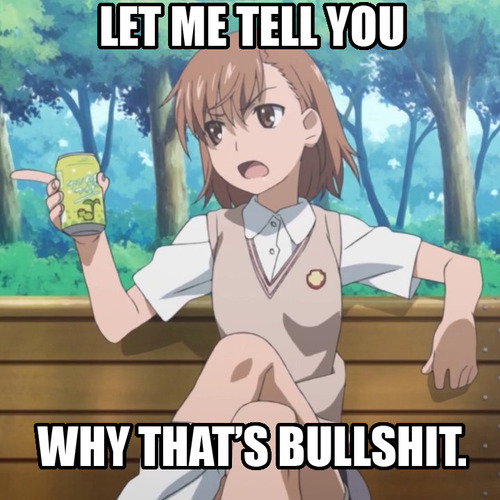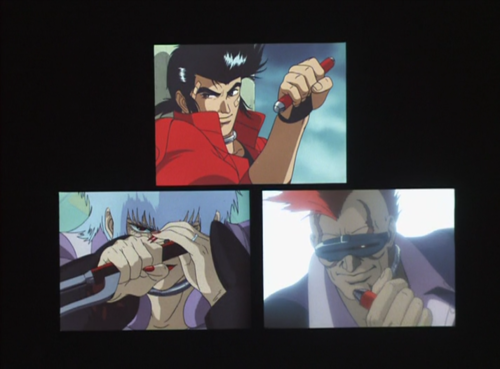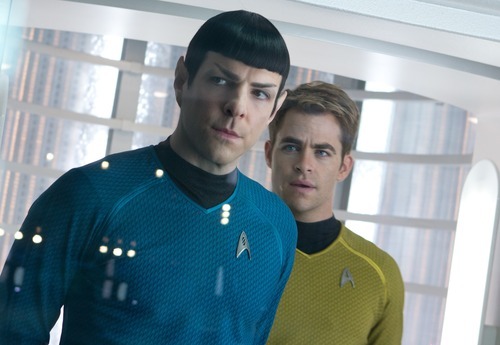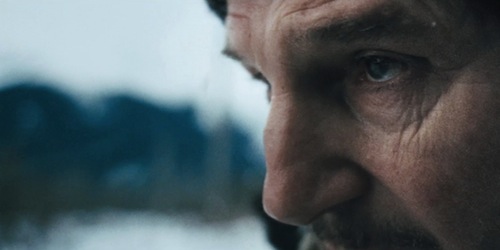The first thing you hear in
Gojira is the sound of rending steal distorted into the roar of an unfathomably huge monster of terrible power. Not a single person in any theatre across the Home Islands had even a moment’s confusion as to what this movie was really about. The year was 1954, not a decade had passed since the horrifying destruction of the American bombing campaign, and just a few months prior a Japanese fishing boat and her crew were irradiated by a nuclear weapons test. Thoughts of science and destruction and the state of Japan in the international community were first and foremost in the minds of the audience, and Toho knew it. Nowadays we call
Gojira “historically and culturally important.” Back then they called it “exploitative.” And it was. Totally. A close reading of the
theatrical trailer may tell us more.
Before we get to that, there’s some groundwork to do. What are we comparing this to? There aren’t really any sources that document how theatrical trailers were put together in 1954 Japan (that I can find), but my own research (watching a bunch on youtube) seems to show that they had a slightly more thematic proclivity than what you’d expect of a western theatrical trailer at the time. This was true both of Shochiku and Toho published films. It’s common to open onto a character speaking about the subject matter, or to some piece of imagery which in some way captures what the film as a whole is like. They’re really quite admirable in some ways. There’s no common structure like what we have now, so I don’t think you could say Gojira really deviated, since there was nothing to deviate from.
Indeed, Gojira is very clear right from the start. What are the images that Toho thought most important to put at the front of the trailer?
00:00-->00:03: Toho logo.
Okay, right after the front of the trailer.
00:03 --> 00:14: Immediately we’re presented with a bit of a difficulty. The shots chosen give the impression of a storm bearing down on an island from the point of view of the people in the midst of if. A shot establishes the force of the storm by showing it blow past trees, and then we cut to show a group of people huddling down behind cover. Another cut, and apparently we’re on the inside of a house as the roof collapses and lightning shines through. Cut again and a man covers his face in terror. On its own, the editing is ambiguous, because it implies spatial relationships between the people outside behind cover, the house, and the man in the house that might not actually exist. And yet, it’s not exactly montage because there is no building of images. Because of this, I’m not sure precisely to what extent I can read this accurately. Nuclear weapons testing took place primarily on islands, and while this figures into the movie itself, I don’t think an audience would consciously look at the images as presented and conclude that it’s a movie about atomic weapons and the devastation in postwar Japan. Typhoons are common enough in Japan that there might not be anything especially unusual.
The strongest tie you might be able to make from atomic weapons to these images is the light coming through the roof, followed by the man in the house covering his face. In the movie, this would have certainly been part of the metaphor.
00:15-->00:20: A boat explodes. A mass of people on the shore of the island stand up and start pointing. The title “Gojira” appears in katakana (the Japanese equivalent of bold face) superimposed.
This, on the other hand, is significantly more clear, and significantly more heavy handed. The reference here is to the Lucky Dragon incident, which took place the first of March, 1954. Filming of Gojira began shortly afterwards, and the film was released in November. The incident occurred when the tuna fishing boat Daigo Fukuryuu Maru (Lucky Dragon Number Five) was caught within the fallout of the Castle Bravo nuclear weapons test conducted by the US over the Bikini Atoll. The captain and crew had believed themselves to be in the safe zone, but unanticipated weather patterns had blown fallout much farther than predicted. The entire crew had been given acute radiation syndrome, and the radio operator died of it in late September of that year, his last words expressing his hope that he would be the last victim of an atomic weapon. The incident would have still been in the news due to negotiations on a settlement between the Japanese and US governments.
Not only would almost any audience member at the time would have recognized this imagery, this imagery (or rather, the seeming reaction of the people on the island to it) is immediately associated with the title of the film.
Now, the audience has no idea what a “Gojira” is. The word doesn’t mean anything in Japanese, and since it’s written in katakana, which is a phonetic way of writing, none of the individual characters have meaning either. The only thing the audience knows about this film so far is that it’s about people in the middle of a disaster which involves suspiciously topical imagery.
00:20-->00:26: Emergency vehicles move past a crowd in the dark. “THE FINAL DAYS OF MANKIND” flies into our faces. This movie is clearly not messing around, no ma’am. There is a distinctly apocalyptic and desperate feeling to this trailer so far, and now Toho is outright telling us “IT’S THE FINAL DAYS OF MANKIND!” They really, really wanted to make the audience feel the terror and panic that the editing, imagery, and dark lighting (did I mention that this film is shot really dark yet?) had been creating and will continue to create throughout the trailer.
00:26-->00:30: A man being restrained warns “the light will enrage him!” The audience responds “who is this him?” What is the cause of this suspiciously topical panic? We must know!
00:30-->00:44: And oh boy does Toho let us know. I cannot embed pictures without padding the length, but go look up historical photos of what firebombing at night looked like, and then watch what unfolds in the trailer. It’s uncanny. On purpose. But let’s still dissect this piece by piece.
The first we see of Gojira is his head imposed on the backdrop of a dark sky, walking through a building, the debris of which is falling towards the camera. There is little depth in this shot, which is one of the many techniques the filmmakers used to make their guy in a rubber suit look more convincingly like a monster, but also serves the purpose of obscuring what this thing actually looks like. So even though the audience could surmise that the giant, vaguely reptilian looking head belongs to “Gojira,” it’s still a bit of a mystery, and the focus is still on the destruction.
It follows, this destruction, in a flurry of edits. Walls collapse and massive flames erupt from the city as the narrator tells us how hydrogen bomb tests have enraged the monster in the pacific. Now we’re drawing fully on the imagery of the allied bombing campaign. The bombings of Hiroshima and Nagasaki are what we think of primarily when we think of the destruction, and the shock of the terrifying and up to that point completely inconceivable power of the atomic weapon was what caused Japan to surrender, but what would have been more familiar to the people who had lived through the war would be the destruction of the firebombing. More people died in the firebombing of Tokyo than in either Hiroshima or Nagasaki, and in fact, the route Gojira takes to Tokyo is the same one the B-29s took. Gojira may be a metaphor for atomic weapons, but the imagery the filmmakers are using is the much more familiar imagery associated with that, and it’s this imagery Toho chooses to show off to market their film.
It follows, this destruction, in a flurry of edits. Walls collapse and massive flames erupt from the city as the narrator tells us how hydrogen bomb tests have enraged the monster in the pacific. Now we’re drawing fully on the imagery of the allied bombing campaign. The bombings of Hiroshima and Nagasaki are what we think of primarily when we think of the destruction, and the shock of the terrifying and up to that point completely inconceivable power of the atomic weapon was what caused Japan to surrender, but what would have been more familiar to the people who had lived through the war would be the destruction of the firebombing. More people died in the firebombing of Tokyo than in either Hiroshima or Nagasaki, and in fact, the route Gojira takes to Tokyo is the same one the B-29s took. Gojira may be a metaphor for atomic weapons, but the imagery the filmmakers are using is the much more familiar imagery associated with that, and it’s this imagery Toho chooses to show off to market their film.
Finally Gojira appears in full view, walking through the city and breathing radioactive flames, as the narrator talks about the monster releasing radioactivity in Tokyo. At this point, Gojira as a monster is fully associated with atomic weapons.
A shot of a burning building is held for longer than normal as a buffer between this flurry of imagery to the next point the trailer tries to hit.
00:44-->01:05: Having made a visceral impression on the audience, the trailer shifts gears and we start discussing the more intellectual engagement of this movie, with a conversation between two characters. There’s nothing particularly special about how this shot is framed or anything, the dialog is the focus. The older fellow says “Gojira is unknown to science; a fantastic opportunity for Japan.” The younger fellow objects “but we can’t just let it wreak havoc.” This is one of the larger conflicts from the movie, epitomized in this exchange.
Oh hey, guess when Japan first started building nuclear power plants. 1954. Eventful year.
Japan uses science-fiction to deal with the question of “can we use this thing which caused so much destruction for good” a heck of a lot. Gojira does it. Astro Boy does it. Space Battleship Yamato does it. But the fact that the first real dialog we see in this trailer – the first glimpse of the characters – is of them literally discussing the metaphor of the movie tells us that maybe this is what Toho wanted the audience to walk away with.
01:05-->01:17: Here, we see the younger man from before ask a man wearing an eyepatch (because of course he is) to reconsider diving even though he isn’t a diver, to which the eyepatched man replies that so long as he’s alive, he may be “forced to use it again.” We then cut to the woman in the background of the previous scene, who asks “what if it’s used for evil purposes?” This sequence shows one of the stranger quirks of the actual movie: that it seems to have not one but two metaphors for nuclear power going on. Gojira is the destruction of nuclear weapons – nuclear energy as a destructive force – while Serizawa’s invention (the oxygen destroyer) is a metaphor of nuclear energy used for good. There’s no reason to introduce this in the trailer itself, however, except to let the audience know even more that this movie is not solely exploiting the imagery of destruction but actually discussing it as well. That said, simply putting this in the trailer out of context, favoring it over any sort of emphasis on character, is a way of exploitation too.
01:17-->01:22: “What is this terrible invention of young scientist Serizawa’s?” asks the trailer as it pans over a generic 50s B-movie laboratory set. I do wonder. It does deserve mentioning that this is the first time anyone’s name is mentioned in the trailer. The characters are just that unimportant to Toho.
01:22-->01:29: Here we have a sequence of images which imply character conflict. That is, the trailer is trying to let the audience know that not only is there the external conflict of Gojira vs the world (but actually just Japan), but also internal conflict not dissimilar to the internal conflicts of the discussion of nuclear power.
01:29-->01:34: But in case the audience had forgotten, we have two shots which show Gojira breathing radioactive fire on a sporty looking car. I don’t think I can really draw any semiotic significance from this since that would probably be giving the editors too much credit, and I don’t think a Japanese audience would react to it in any special way. This part seems primarily just there to remind us of the monster’s existence and provide context for the next sequence.
01:34-->01:35: People running away. Presumably from Gojira. Scenes like this were probably common during the bombing campaign, but what’s interesting is that the editing seems to imply that they’re all running towards…
01:35-->01:46: …some sort of official looking meeting of official looking people in an official looking room. While the trailer has let the audience know that this movie is in some ways about Japan as a whole, this is the first time Toho gives us images of a definitely public body. After the experience of World War 2, there wasn’t exactly a strong desire for nationalistic or authoritarian imagery in films, so this makes perfect sense. The government is fairly useless in the film itself as well.
What’s interesting is that the superimposed titles associate these images with a conflict of “love versus reason.” I’m not exactly sure what to make of it myself. “Love versus reason” is a common theme across cultures and time, and there are some Japanese films of the period which also deal with something like that, but there’s no reason in particular for its association here. Maybe I’m just missing something.
01:46-->01:58: We have images of the military mobilizing and civilians in cramped quarters, the former being “land, sea, and air forces with the latest weapons,” and the latter “refugees fleeing from Gojira.” Some of these “refugees” are seen protesting out in front of a governmental building. Toho seems to want to play off fears that the government may be powerless to do anything to prevent nuclear weapons from becoming a threat to Japan. The movie seems to agree with this sentiment: some dude with a cool eyepatch is the savior here, not the JSDF.
I should note now – and it will become more relevant later – that the JSDF is using American equipment here. There’s a sentiment here that is not precisely anti-American, but is certainly in favor of Japan not relying on America to solve its problems. At the time, America was still very much involved in Japanese policy making, both public and foreign. So this trailer isn’t entirely one-note.
01:58-->02:06: Here, a politician tries to argue for covering up Gojira for the sake of Japan’s standing in the international community, and the official people in the official meeting make a clamor in protest. More text along the lines of what the trailer has already said of the government.
02:06-->02:12: Kyohei tells HIdeto they’re counting on him, as the trailer asks us “can we defeat Gojira?” I think this may be the first sequence in the whole trailer that isn’t in some way exploiting the zeitgeist of 1954 Japan. It’s just a man saying “Hideto-kun…we’re counting on you,” and Hideto responding with a confident “yes sir.” Very ordinary action-adventure movie like.
02:12-->02:45: The trailer’s final few shots are of the JSDF (again, using American equipment) attacking Gojira as the trailer proclaims how the special effects surpass American films, and how much money and talent went into the making of this spectacle. This is fairly ordinary for action movies like this to claim, but comparing Gojira to American films definitely seems like an appeal to the sentiment of the time, especially when paired against images of American-produced F-86s, American produced M2 machine guns, and American produced 88mm howitzers failing to take down the monster, as is made apparent when in the very next shot Gojira smashes into a train.
The parting words: “the year’s most talked about film.” Well, Toho sure tried their damndest to make it so.
To conclude, if you were to ask me how Gojira was marketed to the Japanese moviegoing audience of 1954 – what the underlying expectations were – I would answer you this: “just watch the trailer, it will tell you everything you need to know.” Toho expected a genderless audience of Japanese moviegoers 20 and up who had at least a peripheral knowledge of the day’s issues and sharp childhood memories of what Japan during the final days of The Second World War was like. They expected them to respond to the trailer’s imagery and for word of mouth to spread.
And they did.
 Gen Urobuchi is a little bit like Homura, and not only because they both look like they could fuck up your day, hardcore. See, he too had to find a way to bring Madoka back, and he had to break his world to do so. I’ve thought of a bunch of different silly readings you could make of the movie, but by far my favorite is the one where the movie is a metaphor for itself. All the characters live on in doujinshiland doing happy things, but no mere contrivance could make things like that. A disinterested race has put Homura in limbo and are trying to recapture Madoka’s power - bring back the old days for their own benefit. Homura doesn’t want a reset though: she wants to write her own ending. So she does something dramatic: breaks the Law of Cycles and undeifies Madoka.
Gen Urobuchi is a little bit like Homura, and not only because they both look like they could fuck up your day, hardcore. See, he too had to find a way to bring Madoka back, and he had to break his world to do so. I’ve thought of a bunch of different silly readings you could make of the movie, but by far my favorite is the one where the movie is a metaphor for itself. All the characters live on in doujinshiland doing happy things, but no mere contrivance could make things like that. A disinterested race has put Homura in limbo and are trying to recapture Madoka’s power - bring back the old days for their own benefit. Homura doesn’t want a reset though: she wants to write her own ending. So she does something dramatic: breaks the Law of Cycles and undeifies Madoka.














